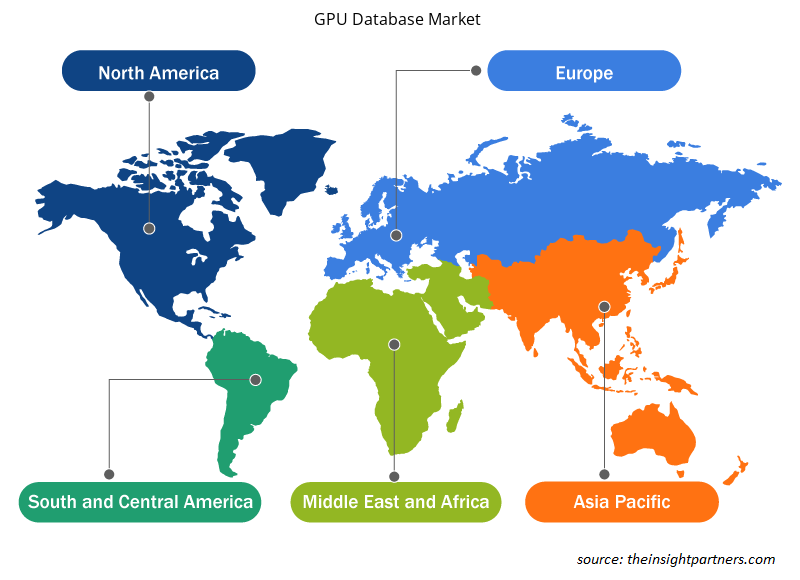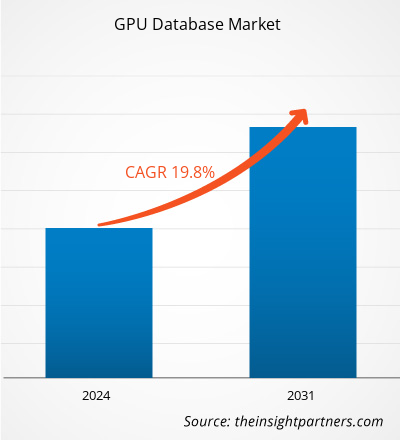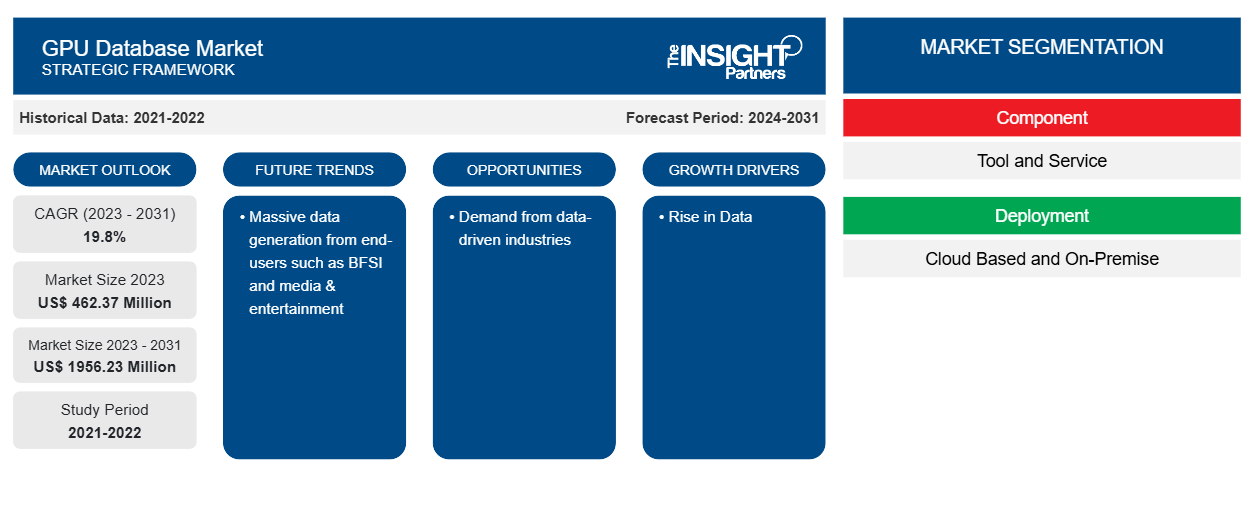Der Markt für GPU-Datenbanken soll von 462,37 Millionen US-Dollar im Jahr 2023 auf 1.956,23 Millionen US-Dollar im Jahr 2031 anwachsen. Der Markt soll zwischen 2023 und 2031 eine durchschnittliche jährliche Wachstumsrate (CAGR) von 19,8 % verzeichnen. Der Anstieg der Daten und die wachsenden datengesteuerten Branchen werden voraussichtlich weiterhin wichtige Trends auf dem Markt bleiben.CAGR of 19.8% during 2023–2031. The rise in data and the growing data-driven industries are likely to remain key trends in the market.
GPU-Datenbank-Marktanalyse
Die wachsenden datengesteuerten Branchen sind einer der wichtigsten Antriebsfaktoren für den GPU-Datenbankmarkt. Der Anstieg der Digitalisierung und die Neigung der Unternehmen zu Lösungen zur Verarbeitung großer Datensätze treiben das Marktwachstum voran. Die GPU-Datenbank findet ihre Anwendung in einigen der aufkommenden Technologien wie künstlicher Intelligenz, maschinellem und tiefem Lernen, dem Internet der Dinge (IoT) und der Geodatenanalyse, was enorme Chancen für das Wachstum des GPU-Datenbankmarktes schafft.
Marktübersicht für GPU-Datenbanken
Eine GPU-Datenbank verwendet Grafikprozessoren (GPUs), um Datenbankoperationen auszuführen. Eine GPU ist ein programmierbarer Prozessor, der hochauflösende Bilder und Videos schnell rendern soll. Die GPU-Datenbank verarbeitet riesige Datenmengen schneller und effektiver als CPUs, da sie parallel statt nacheinander arbeitet. Daher sind GPU-Datenbanken in der Regel schneller und auf Analysen ausgerichtet, die flexibler bei der Verarbeitung vieler verschiedener Datentypen oder viel größerer Datenmengen sind.
Passen Sie diesen Bericht Ihren Anforderungen an
Sie erhalten kostenlos individuelle Anpassungen an jedem Bericht, einschließlich Teilen dieses Berichts oder einer Analyse auf Länderebene, eines Excel-Datenpakets sowie tolle Angebote und Rabatte für Start-ups und Universitäten.
-
Holen Sie sich die wichtigsten Markttrends aus diesem Bericht.Dieses KOSTENLOSE Beispiel umfasst eine Datenanalyse von Markttrends bis hin zu Schätzungen und Prognosen.
Treiber und Chancen auf dem GPU-Datenbankmarkt
Anstieg der Daten begünstigt den Markt
Mit dem Aufkommen der Digitalisierung werden Daten mit enormer Geschwindigkeit generiert. Die Daten unterschiedlicher Art, Menge und Geschwindigkeit müssen analysiert und verarbeitet werden, um mithilfe von Datenanalysetechniken verborgene Muster und Erkenntnisse zu ermitteln . Herkömmliche Analysen bieten keine optimalen Analysetechniken und -technologien. Dies führt zur Notwendigkeit einer GPU-Datenbank. Mit ihren massiv parallelen Verarbeitungsfunktionen bietet eine GPU-Datenbank kostengünstiges Hochleistungsrechnen. Eine GPU-Datenbank ist eine ideale Lösung für die Verarbeitung großer Datensätze, was die Nachfrage nach dieser Technologie antreibt.
Nachfrage aus datengetriebenen Branchen.
GPU-Daten haben eine hohe Rechenleistung. Aufgrund ihrer parallelen Verarbeitungsfähigkeiten können sie Daten bis zu 100-mal schneller verarbeiten als Konfigurationen, die nur CPUs enthalten, wie dargestellt. Daher verlangen verschiedene datengesteuerte Branchen wie BFSI, Medien und Unterhaltung und andere nach Lösungen für verarbeitungsintensive Workloads für Datenanalyseanwendungen, was die Nachfrage nach GPU-Datenbanken antreibt. Die Marktteilnehmer bringen Lösungen auf den Markt, um dieser Nachfrage gerecht zu werden. Graphistry hat Hub Pro (Graphistry Hub for Professionals) auf den Markt gebracht, um Kunden GPU-beschleunigte visuelle Graphanalysen anzubieten. Graphistry Hub Pro löst Probleme in den Bereichen Sicherheit, Preisgestaltung und Wartung für Einzelpersonen und die kommenden Hub Organizations für Teams. (Quelle: Graphistry, Pressemitteilung, September 2021)CPUs, as illustrated. Thus, various data-driven industries such as BFSI, media & entertainment, and others demand solutions to processing-intensive workloads for data analytics applications, which drives the demand for GPU databases. The market players are launching solutions to cater to this demand. Graphistry launched Hub Pro (Graphistry Hub for Professionals) to bring GPU-accelerated visual graph analysis to customers. Graphistry Hub Pro solves security, pricing, and maintenance for individuals, and the upcoming Hub Organizations for teams. (Source: Graphistry, Press Release, September 2021)
Segmentierungsanalyse des GPU-Datenbankmarktberichts
Wichtige Segmente, die zur Ableitung der GPU-Datenbankmarktanalyse beigetragen haben, sind Komponente, Bereitstellung, Anwendung und Branche.
- Basierend auf der Komponente ist der GPU-Datenbankmarkt in Tool und Service unterteilt. Das Tool-Segment hielt im Jahr 2023 den größten Marktanteil.
- Der Markt ist nach Bereitstellung in Cloud-basierte und On-Premise-Lösungen segmentiert. Die Cloud-basierten Lösungen werden voraussichtlich die höchste jährliche Wachstumsrate aufweisen.CAGR.
- Nach Anwendung ist der Markt in Betrugserkennung und -prävention, Governance Risk & Compliance (GRC), Customer Experience Management, vorausschauende Wartung, Supply Chain Management, Bedrohungsinformationen und andere unterteilt. Das Customer Experience Management hatte im Jahr 2023 einen erheblichen Marktanteil.GRC), customer experience management, predictive maintenance, supply chain management, threat intelligence, and others. The customer experience management held a significant share of the market in 2023.
- Nach Branchen ist der Markt in BFSI, IT & Telekommunikation, Einzelhandel & E-Commerce, Gesundheitswesen, Transport & Logistik, Regierung & Verteidigung und andere unterteilt. Der BFSI hielt im Jahr 2023 einen erheblichen Marktanteil.BFSI, IT & telecom, retail & e-commerce, healthcare, transportation & logistics, government & defense, and others. The BFSI held a significant share of the market in 2023.
GPU-Datenbank-Marktanteilsanalyse nach Geografie
Der geografische Umfang des GPU-Datenbankmarktberichts ist hauptsächlich in fünf Regionen unterteilt: Nordamerika, Asien-Pazifik, Europa, Naher Osten und Afrika sowie Süd- und Mittelamerika.
Der asiatisch-pazifische Raum wird voraussichtlich das höchste CAGR-Wachstum aufweisen. Der Anstieg der Digitalisierung und die wachsende Nachfrage nach fortschrittlichen Datenanalysetechniken in Entwicklungsländern wie Indien und China treiben das Marktwachstum in der Region voran. Die digitale Transformation in datengesteuerten Branchen wie BFSI, Gesundheitswesen, Fertigung und anderen treibt das Marktwachstum weiter voran. Die steigende Nachfrage nach der Gewinnung von Erkenntnissen aus großen Datensätzen treibt das Marktwachstum im asiatisch-pazifischen Raum voran.CAGR. The rise in digitalization and growing demand for advanced data analytics techniques in developing economies such as India and China is driving market growth in the region. Digital transformation across data-driven industries such as BFSI, healthcare, manufacturing, and others, further drives market growth. The increasing demand for extracting insights from large datasets is fuelling the market growth in Asia Pacific.
Regionale Einblicke in den GPU-Datenbankmarkt
Die regionalen Trends und Faktoren, die den GPU-Datenbankmarkt während des Prognosezeitraums beeinflussen, wurden von den Analysten von Insight Partners ausführlich erläutert. In diesem Abschnitt werden auch die GPU-Datenbankmarktsegmente und die Geografie in Nordamerika, Europa, im asiatisch-pazifischen Raum, im Nahen Osten und Afrika sowie in Süd- und Mittelamerika erörtert.

- Erhalten Sie regionalspezifische Daten zum GPU-Datenbankmarkt
Umfang des GPU-Datenbank-Marktberichts
| Berichtsattribut | Details |
|---|---|
| Marktgröße im Jahr 2023 | 462,37 Millionen US-Dollar |
| Marktgröße bis 2031 | 1956,23 Millionen US-Dollar |
| Globale CAGR (2023 - 2031) | 19,8 % |
| Historische Daten | 2021-2022 |
| Prognosezeitraum | 2024–2031 |
| Abgedeckte Segmente |
Nach Komponente
|
| Abgedeckte Regionen und Länder |
Nordamerika
|
| Marktführer und wichtige Unternehmensprofile |
|
Dichte der Marktteilnehmer für GPU-Datenbanken: Auswirkungen auf die Geschäftsdynamik verstehen
Der Markt für GPU-Datenbanken wächst rasant, angetrieben durch die steigende Nachfrage der Endnutzer aufgrund von Faktoren wie sich entwickelnden Verbraucherpräferenzen, technologischen Fortschritten und einem größeren Bewusstsein für die Vorteile des Produkts. Mit steigender Nachfrage erweitern Unternehmen ihr Angebot, entwickeln Innovationen, um die Bedürfnisse der Verbraucher zu erfüllen, und nutzen neue Trends, was das Marktwachstum weiter ankurbelt.
Die Marktteilnehmerdichte bezieht sich auf die Verteilung der Firmen oder Unternehmen, die in einem bestimmten Markt oder einer bestimmten Branche tätig sind. Sie gibt an, wie viele Wettbewerber (Marktteilnehmer) in einem bestimmten Marktraum im Verhältnis zu seiner Größe oder seinem gesamten Marktwert präsent sind.
Die wichtigsten auf dem GPU-Datenbankmarkt tätigen Unternehmen sind:
- BRYTLYT
- GRAFIK
- H2O.ai
- Jedox
- Kinetica DB Inc.
- Neo4J, INC.
Haftungsausschluss : Die oben aufgeführten Unternehmen sind nicht in einer bestimmten Reihenfolge aufgeführt.

- Überblick über die wichtigsten Akteure auf dem GPU-Datenbankmarkt
Neuigkeiten und aktuelle Entwicklungen zum GPU-Datenbankmarkt
Der GPU-Datenbankmarkt wird durch die Erfassung qualitativer und quantitativer Daten nach Primär- und Sekundärforschung bewertet, die wichtige Unternehmensveröffentlichungen, Verbandsdaten und Datenbanken umfasst. Einige der Entwicklungen auf dem GPU-Datenbankmarkt sind unten aufgeführt:
- NVIDIA und HP Inc. haben die Integration von NVIDIA CUDA-X-Datenverarbeitungsbibliotheken in HP AI-Workstation-Lösungen angekündigt, um die Datenaufbereitung und -verarbeitung, die die Grundlage für die Entwicklung generativer KI bildet, zu beschleunigen. Die auf der NVIDIA CUDA-Rechnerplattform basierenden CUDA-X-Bibliotheken beschleunigen die Datenverarbeitung für eine breite Palette von Datentypen, darunter Tabellen, Text, Bilder und Videos. Dazu gehört die NVIDIA RAPIDS cuDF-Bibliothek, die die Arbeit der fast 10 Millionen Datenwissenschaftler, die Pandas-Software verwenden, mit einer NVIDIA RTX 6000 Ada Generation GPU anstelle eines reinen CPU-Systems um das bis zu 110-fache beschleunigt, ohne dass Codeänderungen erforderlich sind. (Quelle: NVIDIA, Pressemitteilung, März 2024)
- Zilliz, ein Vorreiter in der Vektordatenbanktechnologie , hat die Veröffentlichung von Milvus 2.4 angekündigt, das mit einer bahnbrechenden GPU-Indizierungsfunktion auf Basis von NVIDIAs CUDA-Accelerated Graph Index for Vector Retrieval (CAGRA), einem Teil der RAPIDS cuVS-Bibliothek, einen neuen Standard in der Vektorsuchfunktion setzt. (Quelle: Zilliz, Pressemitteilung, März 2024)
Abdeckung und Ergebnisse des GPU-Datenbank-Marktberichts
Der Bericht „GPU-Datenbankmarktgröße und -prognose (2021–2031)“ bietet eine detaillierte Analyse des Marktes, die die folgenden Bereiche abdeckt:
- GPU-Datenbankmarktgröße und -prognose auf globaler, regionaler und Länderebene für alle wichtigen Marktsegmente, die im Rahmen des Berichts abgedeckt sind
- GPU-Datenbankmarkttrends sowie Marktdynamik wie Treiber, Einschränkungen und wichtige Chancen
- Detaillierte PEST/Porters Five Forces- und SWOT-Analyse
- GPU-Datenbankmarktanalyse mit wichtigen Markttrends, globalen und regionalen Rahmenbedingungen, wichtigen Akteuren, Vorschriften und aktuellen Marktentwicklungen
- Branchenlandschaft und Wettbewerbsanalyse, einschließlich Marktkonzentration, Heatmap-Analyse, prominenten Akteuren und aktuellen Entwicklungen für den GPU-Datenbankmarkt
- Detaillierte Firmenprofile
- Historische Analyse (2 Jahre), Basisjahr, Prognose (7 Jahre) mit CAGR
- PEST- und SWOT-Analyse
- Marktgröße Wert/Volumen – Global, Regional, Land
- Branchen- und Wettbewerbslandschaft
- Excel-Datensatz
Aktuelle Berichte
Erfahrungsberichte
Grund zum Kauf
- Fundierte Entscheidungsfindung
- Marktdynamik verstehen
- Wettbewerbsanalyse
- Kundeneinblicke
- Marktprognosen
- Risikominimierung
- Strategische Planung
- Investitionsbegründung
- Identifizierung neuer Märkte
- Verbesserung von Marketingstrategien
- Steigerung der Betriebseffizienz
- Anpassung an regulatorische Trends























 Kostenlose Probe anfordern für - GPU-Datenbankmarkt
Kostenlose Probe anfordern für - GPU-Datenbankmarkt